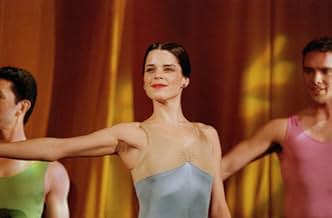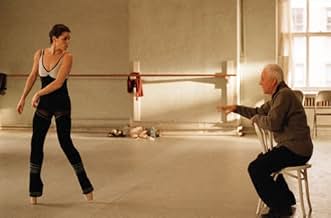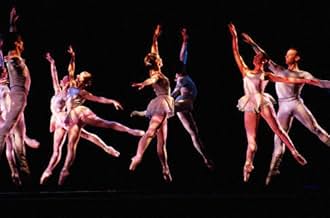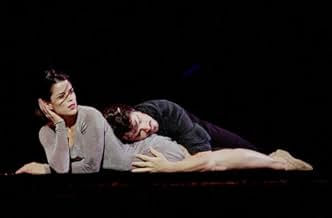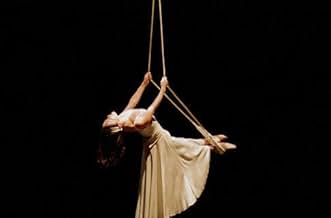AVALIAÇÃO DA IMDb
6,2/10
7 mil
SUA AVALIAÇÃO
Focado em um grupo de dançarinos de balé, com foco em um jovem dançarino que está pronto para se tornar um ator principal.Focado em um grupo de dançarinos de balé, com foco em um jovem dançarino que está pronto para se tornar um ator principal.Focado em um grupo de dançarinos de balé, com foco em um jovem dançarino que está pronto para se tornar um ator principal.
- Direção
- Roteiristas
- Artistas
- Prêmios
- 2 indicações no total
Barbara E. Robertson
- Harriet
- (as Barbara Robertson)
Davis C. Robertson
- Alec - Joffrey Dancer
- (as Davis Robertson)
Avaliações em destaque
Ugh. The problem with The Company is that it's not a Robert Altman film. His touch is evident in the filmmaking and fly-on-the-Wall feel of the movie, but it's not his movie. It's Neve Campbell's, who wrote, produced, and starred in it. Campbell spent years with the national ballet and this movie was a labor of that passion. However, that is precisely where it goes wrong. It shoots for the wrong audience. Dancers will likely love this movie but they are the choir. They know how a dance company works, the back dealing and politics. They don't need this movie. The rest of us don't learn anything, or at least learn just enough to know that professional dancing is a horrible way to live. The dancing was beautiful, including Neve's, although she doesn't look quite as polished as her back ups in the company, but the characters were shallow and you are never given anything to grab onto to care about any of them. The only ones you root for the ones who are injured or fired so they can get out of that horrible horrible place. Such a disappointment on so many levels. The only thing that does come off well is the Joffrey. You actually leave the theater wondering if the Ballet company underwrote the production as a marketing expense.
I suppose you can call this splendid movie a documentary showing several months in the life of the Joffrey Ballet of Chicago. However, as there are some dramatized elements (albeit to a minimum), you can't technically call it a documentary. And yet, it's more truthful than many "full" documentaries. Completely free from contamination of melodrama, the movie shows us, in a matter-of-fact manner, things behind the stage dedication and sacrifices, lucky breaks that even the top talents sometimes need, experienced performers arguing anainst new ideas, injury and understudy stepping in at a moment's notice, disappointment from being fired, and much more.
Doing what he does best, master Altman gives you an inconspicuous spot in the rehearsal hall, in the meeting room, back stage, to show you how an idea evolves right from an artist's concept to a successful performance the road that is sometimes painful, sometimes exhilarating and everything in between, the process that affects the lives of the people who are part of the whole. Overlapping dialogue here is not just Altman's artistic and technical trademark, but the way people REALLY speak. Through his amazing deployment of the camera, he also gives the audience a kaleidoscope of events and emotions that are fleeting and fluid, and yet remain with you long after the movie.
In addition to the insight of the documentary, dance lovers will enjoy the generous helping of dance scenes, particularly the outdoor performance in a thunder storm at the beginning. And although personal story is not the point of this movie, the depiction of the relationship between the characters played by Neve Campbell (the dancer) and James Franco (the chef) is wonderful. The scene of their first meeting is a joy to watch she is playing pool by herself and really enjoying it while he, a drink in hand, regards her somewhat stoically at a distance. The two of them are depicted in so many angles, sometimes in the same frame, sometimes separately. This scene is so mesmerizing that you'll forget the passage of time. At long last, they make eye contact and smile. Then, a cut to the next morning in her apartment when they are just waking up, as he offers to cook breakfast for them. An absolutely beautiful sequence.
Campbell and Franco are simply wonderful. The icon of the movie, however, is artistic director of the company Alberto Antonelli , generally known as "Mr A", who comes off larger than life with the flare of Malcolm McDowell, who undoubted is remembered best from "A clockwork orange".
To people who have experienced the joy of stage performance, even in a very modest way of an amateur choir or theatre group, there is the bonus of additional empathy the sometimes not so smooth rehearsals, the panic as the performance approaches and nothing seems to work, the last minute jitters before curtain, the final jubilation when everything miraculously falls into place and the sincere applause of the audience. Such empathy!
Doing what he does best, master Altman gives you an inconspicuous spot in the rehearsal hall, in the meeting room, back stage, to show you how an idea evolves right from an artist's concept to a successful performance the road that is sometimes painful, sometimes exhilarating and everything in between, the process that affects the lives of the people who are part of the whole. Overlapping dialogue here is not just Altman's artistic and technical trademark, but the way people REALLY speak. Through his amazing deployment of the camera, he also gives the audience a kaleidoscope of events and emotions that are fleeting and fluid, and yet remain with you long after the movie.
In addition to the insight of the documentary, dance lovers will enjoy the generous helping of dance scenes, particularly the outdoor performance in a thunder storm at the beginning. And although personal story is not the point of this movie, the depiction of the relationship between the characters played by Neve Campbell (the dancer) and James Franco (the chef) is wonderful. The scene of their first meeting is a joy to watch she is playing pool by herself and really enjoying it while he, a drink in hand, regards her somewhat stoically at a distance. The two of them are depicted in so many angles, sometimes in the same frame, sometimes separately. This scene is so mesmerizing that you'll forget the passage of time. At long last, they make eye contact and smile. Then, a cut to the next morning in her apartment when they are just waking up, as he offers to cook breakfast for them. An absolutely beautiful sequence.
Campbell and Franco are simply wonderful. The icon of the movie, however, is artistic director of the company Alberto Antonelli , generally known as "Mr A", who comes off larger than life with the flare of Malcolm McDowell, who undoubted is remembered best from "A clockwork orange".
To people who have experienced the joy of stage performance, even in a very modest way of an amateur choir or theatre group, there is the bonus of additional empathy the sometimes not so smooth rehearsals, the panic as the performance approaches and nothing seems to work, the last minute jitters before curtain, the final jubilation when everything miraculously falls into place and the sincere applause of the audience. Such empathy!
Lets hope that Altman makes films for another 20 years and that he stays as adventuresome as he currently is.
In 'The Long Goodbye' Altman invented a rather new camera stance, literally asking the actors to improvise staging and having the camera discovering them.
It took a few decades for him to get back to such experiments with 'Gosford.' Now he takes it even further with perhaps the purest problem in film cinematography: how do you film dance?
Forget that this features Campbell in a vanity role: she is good enough and doesn't detract. Forget about any modicum of plot: there isn't any. And unlike 'Nashville' or the similarly selfreferential 'Player' there is no cynical commentary.
The commentary itself is selfreferential this time. Yes, this time the center of the film is how 'Mr A' orchestrates movement and images. This is most of all about himself, and is far, far more intelligent and subtle than say, 'Blowup.'
But along the way, you get possibly the best dance experience on film. That's because they've been able to use many cameras. There are not as many as 'Dancer in the Dark,' but each camera dances, engages with the dance and the dance of people and objects around the dance. So we get four layers of dance: the actual ballet, the orchestration of people around the production, the dancing cameras (enhanced by non-radical appearing radical editing) and the dance within the mind of Mr A who encourages, follows and captures them all.
Ted's Evaluation -- 3 of 3: Worth watching.
In 'The Long Goodbye' Altman invented a rather new camera stance, literally asking the actors to improvise staging and having the camera discovering them.
It took a few decades for him to get back to such experiments with 'Gosford.' Now he takes it even further with perhaps the purest problem in film cinematography: how do you film dance?
Forget that this features Campbell in a vanity role: she is good enough and doesn't detract. Forget about any modicum of plot: there isn't any. And unlike 'Nashville' or the similarly selfreferential 'Player' there is no cynical commentary.
The commentary itself is selfreferential this time. Yes, this time the center of the film is how 'Mr A' orchestrates movement and images. This is most of all about himself, and is far, far more intelligent and subtle than say, 'Blowup.'
But along the way, you get possibly the best dance experience on film. That's because they've been able to use many cameras. There are not as many as 'Dancer in the Dark,' but each camera dances, engages with the dance and the dance of people and objects around the dance. So we get four layers of dance: the actual ballet, the orchestration of people around the production, the dancing cameras (enhanced by non-radical appearing radical editing) and the dance within the mind of Mr A who encourages, follows and captures them all.
Ted's Evaluation -- 3 of 3: Worth watching.
Some of the dances are tiny religious experiences. The film doesn't look nearly as good as some of Altman's others, but there are flashes of awesome beauty: a topless male dancer alone in a room with golden beams of light, and Neve Campbell in her bath. The movie looks at the queeny pretensions of the boys (and their fathers), the dancers' sex lives (who are more '60s than their instructor knows), and the company leader, played by Malcolm McDowell, whose occasional flakiness is caught by one black dancer. I couldn't help but think of McDowell as an Altman self-criticism: an elderly director working with small budgets, prone to artiness, who champions art as being organic, who rounds up a large crew of performers and calls them "babies." The day-in-the-life shapelessness of the movie didn't at all bother me, though one character, who asks to stay in a dancer's apartment, is dropped pretty quickly. And James Franco is in it. 9/10
If you're a devoted fan of ballet or modern dance, you'll enjoy "The Company." Neve Campbell is Ry, a young ballerina and the focal point of the movie, which is an almost documentary-like portrayal of a professional ballet company preparing for and delivering spectacular dance performances in Chicago. Campbell is a former professional dancer, so she brings authenticity to her performance. However, despite the casting of Malcolm McDowell as an authoritarian, acid-tongued company director to provide a potential source of dramatic conflict with Campbell's character, there's very little story or dialogue in the whole film. Some of the dialogue is so quiet and natural that you can't really make it out. Directed by the great Robert Altman, "The Company" focuses mostly on dance performances and grueling practices, with a few cliches thrown in (the dancers' struggles to win roles, please the choreographer and make ends meet financially). It all looks very realistic and beautiful, and the drama is only in the dance. There's a sweet, slight love story for Ry and her equally hard-working chef beau, played by James Franco. So enjoy "The Company" on a quiet evening, glass of wine in hand, if you love to watch good dance performances, but not if you want dialogue or plot. Still, kudos to Neve Campbell for getting such a tasteful, lovely, non-commercial movie made.
Você sabia?
- CuriosidadesNeve Campbell lost thousands of dollars of her own money to ensure that her fellow cast members received their wages.
- Erros de gravaçãoAt about 1:10 while counting during a rehearsal, Harriet skips the 6th count of 8.
- Citações
Alberto Antonelli: Ry, honey, let's scramble some ideas, instead of some asshole who contradicts me.
- Cenas durante ou pós-créditosAfter the closing credits begin rolling, the dancers continue to take their final bows, and the audience continues to applaud.
Principais escolhas
Faça login para avaliar e ver a lista de recomendações personalizadas
- How long is The Company?Fornecido pela Alexa
Detalhes
Bilheteria
- Orçamento
- US$ 15.000.000 (estimativa)
- Faturamento bruto nos EUA e Canadá
- US$ 2.283.914
- Fim de semana de estreia nos EUA e Canadá
- US$ 93.776
- 28 de dez. de 2003
- Faturamento bruto mundial
- US$ 6.415.017
- Tempo de duração
- 1 h 52 min(112 min)
- Cor
- Mixagem de som
- Proporção
- 2.35 : 1
Contribua para esta página
Sugerir uma alteração ou adicionar conteúdo ausente








